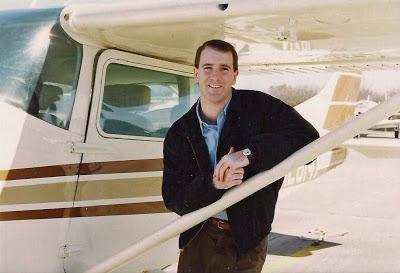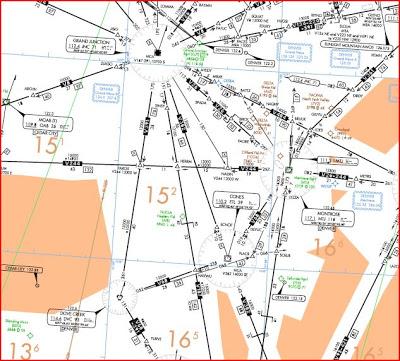As I prepared for my interview, I remember being stumped by a question that is still commonly used today. "What is the dumbest thing you have ever done in an airplane?" That question is fraught with opportunity to sink your chances of employment. Everyone has done something stupid in the cockpit. Your presence at the interview is a good indication that you lived through the experience, managed to elude the watchful eye of the FAA, and hopefully learned something in the process. How honest and forthcoming should you be? On one hand, if you share something too extreme, then you may call into question your ability to make wise and timely decisions...a personality trait incongruous with work as an airline pilot. On the other hand, denying that you have ever made some ill-advised decision as a pilot will only label you as a liar...choose wisely.
In the end, I told a story that illustrated the fact that I am human, but that I am not dangerous or flippant about the decisions I make in the cockpit and that I learn from my mistakes.
When I look back at the early stages of my aviation career, I am amazed by some of the open doors that were presented to me. It was as if aviation was a predetermined destination. My college roommate was one of those open doors. He came from a wealthy family who owned a nationwide department store chain and a number of airplanes. Just about every member of the family either owned or had access to an airplane and most everyone had their pilot's license. My roommate was no exception and as a freshman in college, his father sent him to school with his very own Cessna 182. It was a beautiful old airplane, restored from the ground up, well equipped with all the latest avionics and what we jokingly called an "off-road" package. It had a STOL kit with drooping ailerons and fat tires for off airport landings and was capable of alarmingly short takeoff and landing rolls.

I was permitted to fly that wonderful airplane for the ridiculous sum of $15 per hour. A crazy amount for a very nice airplane...the money intended to offset future maintenance costs. I got my instrument rating in the 182 and just before I started working on my Commercial, my roommate decided he was tired of the old girl and talked good ole dad into a Cessna 210. The airplane was not new or in particularly good condition, but that would change over time.
The family also had a house near Aspen, Colorado, so one spring break, four of us loaded up the 210 and headed for the slopes. Four college kids in an expensive single-engine airplane flying into mountainous terrain...what could possibly go wrong?
As a side note, I flew small freight in a T210 a few years later. The airplane was known for its capability to fly with just about anything you could fit through the door. It was a workhorse...strong, reliable and easy to fly with a safety record that reflected its abilities. I would perform the necessary calculations to determine how much weight I could legally and safely carry and as I did this, ramp personnel would approach the airplane with a huge cart full of mail, cancelled checks, small parcels and whatever else needed be carried. I would hand the load agent a slip of paper explaining how much I could take...and amazingly...the contents of his cart weight exactly that amount.
I'm sure I don't need to explain what I am suggesting, but what an incredible coincidence! The truth was, I never knew exactly what my airplane weighed and I flew it accordingly. A little...no, make it a lot...of extra speed on takeoff and landing and the T210 always flew. It was legal on paper even if I strongly suspected foul play.
Back to the story...
We planned the trip carefully, weighed all our belongings and performed the required weight and balance calculations. Unlike my days as a freight pilot, we knew exactly what the airplane weighed. We intentionally departed early in the morning because we knew it was against airport rules, not to mention unnecessarily dangerous, to land in Aspen after dark. In the early morning hours on the first day of spring break, my roommate performed a walk-around inspection of the 210 while the rest of us loaded the aircraft per the plan.
Lesson one: Trust but verify.
Three of the four of us were pilots, me included. My roommate, as the owner of the airplane, had ample experience and enough time in the 210 to be reasonably comfortable in the pilot seat. He chose to fly. I had around 500 hours flight experience at the time, was current and checked out in the airplane and claimed the other front seat. In the back was a friend who was not a pilot and one more friend who had more flying experienced than the rest of us put together. There was plenty of knowledge and experience in the airplane that day; we had planned the trip meticulously and expected a safe and smooth flight. What I did not know, was that my good friend who performed the pre-flight inspection had not secured the cap after checking the engine oil.
After an uneventful engine start and taxi, we sat at the end of the runway for several minutes performing checklist and a run-up inspection on the engine and flight instruments. The tower cleared us for takeoff and within a minute, we were climbing past the departure end of the runway. I vividly remember the moment right before all hell broke loose. I took a deep breath of brisk spring air and marveled out my window at the colorful morning sky.
Loud cursing from the left seat rose above the sound of the engine and brought me back from my daydream. I moved to look in the direction of all the commotion but what grabbed my attention a huge blackish brown glob of liquid quickly filling the windscreen. My friend immediately banked the airplane into a hard right hand turn, but he had a lack of understanding when it came to accelerated stalls that almost resulted in a loss of control. The fact that we could barely see anything out the window combined with emergency radio calls to the tower and my repeated efforts to override my buddy and his attempts to stall the airplane terminated with a smooth landing on a cross-runway before the engine seized.
We rolled off the runway under our own power and promptly shut down the engine. It couldn't have been more than a minute or two before an airport crash, fire and rescue team arrived to assist. A quick inspection confirmed that the engine oil cap had not been properly secured and luckily, what looked like gallons of oil on the window was actually a fairly small percentage of what was available to lubricate the engine. We had the plane towed to the hangar, inspected, cleaned up and topped off with both oil and fuel before we made a second and more successful attempt to depart.
I honestly cannot remember a time before or after this trip when I flew in a small plane and did not perform my own walk-around inspection. Lesson learned. If you have the opportunity to do so, verify the condition and readiness of your craft...even if you're just a passenger.
Lesson Two: Just because it's legal doesn't make it smart.
Other than bruised egos, the only real consequence of the morning's events was a complete trashing of our carefully planned schedule. The route of flight that day was planned from College Station, Texas (KCLL) to Dallas Love Field (KDAL) to pick up some ski equipment and fuel, then non-stop to Aspen, Colorado (KASE) in day VFR conditions. A significantly tardy departure on the first leg of the trip meant we would not arrive in Aspen during daylight hours. The consensus was that we would press on to Albuquerque, New Mexico (KABQ) for another fuel stop, then fly a night leg between Albuquerque and Grand Junction, Colorado (KGJC) where we would leave the plane and rent a car.
You know the little voice in your head that warns of impending disaster? I had a long conversation with that voice before we departed Albuquerque...at night...over, or rather through, mountainous terrain...in an old, single engine airplane that I didn't know well enough to trust. It was not a wise decision.
I am reminded of countless conversations I've had over the years as a professional pilot with crew schedule, line maintenance and flight dispatch. I would hate to admit how many times I have uttered the words "it may be legal, but it isn't safe and I'm not doing it." Not surprisingly, once the safety of flight is brought into question, I rarely get push back from the other end of that conversation. But on this flight, worn down after a long travel day and suffering from a severe case of "get-there-itis," the conversation was internal and I didn't heed my own advice.
With my old roommate at the controls once again, we departed Albuquerque on a visual flight plan under high overcast clouds and a moonless sky...it was very dark. We went out of our way to fly protected IFR routing and were forced to climb to 12,500 feet just to remain a minimum distance above terrain. Anyone who has ever flown a single engine airplane over mountainous terrain, open water or anywhere else where options are few will tell you they become very in-tune with their airplane.

As we continued along V391 between Dove Creek and Grand Junction, the last leg of our journey, I clearly remember every little hiccup and burble from the engine. Every ripple in the air sent chills down my spine. I remember watching white topped mountain peaks slip by at about our altitude, some above, barely visible in the night, wondering if or when we would be found if the engine quit. Allow me to repeat myself. It was not a wise decision.
As the old saying goes...I would rather be lucky than good. We got lucky that night. Tired and armed with few options for escape in the event of some unforeseen calamity, we were granted safe passage and allowed to cheat death another day. After an unnervingly stressful flight, we let down in a circle pattern over the relative safety of a well-lit Grand Junction, Colorado. As we walked away from the airplane, the little voice in my head was scolding me for not paying more attention to my concerns. I vowed to never let it happen again.
As for the interview, I was offered a job at both the companies where I shared this story, so all I really know is that my choice didn't get me blackballed. I suggest you choose carefully...and listen to that little voice.
